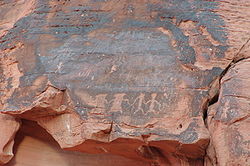- Desert varnish
-
Desert varnish, or rock varnish is a orange-yellow to black coating found on exposed rock surfaces in arid environments. Desert varnish is usually around one micron thick and present nanometre-scale layering [1]. Rock rust and desert patina are other terms which are also used for the condition, but less often.
Contents
Formation
Desert varnish forms only on physically stable rock surfaces that are no longer subject to frequent precipitation, fracturing or wind abrasion. The varnish is primarily composed of particles of clay along with iron and manganese oxides.[2] There is also a host of trace elements and almost always some organic matter. The colour of the varnish varies from shades of brown to black.[3]
Composition
 Desert varnish on Bishop Tuff.
Desert varnish on Bishop Tuff.
Originally scientists thought that the varnish was made from substances drawn out of the rocks it coats.[4] Microscopic and microchemical observations, however, show that a major part of varnish is clay, which could only arrive by wind.[5] Clay, then, acts as a substrate to catch additional substances that chemically react together when the rock reaches high temperatures in the desert sun. Wetting by dew is also important in the process.[3]
An important characteristic of black desert varnish is that it has an unusually high concentration of manganese. Manganese is relatively rare in the Earth's crust, making up only 0.12% of its weight. In black desert varnish, however, manganese is 50 to 60 times more abundant. This significant enrichment is thought to be caused by manganese-oxidizing microbes (mixotrophs) which are common in environments poor in organic nutrients. A micro-environment pH above 7.5 is inhospitable for manganese-concentrating microbes. In such conditions manganese-poor (Fe-rich) orange varnishes develop [6]. An alternative hypothesis for Mn/Fe fluctuation has been proposed that consider Mn-rich and Fe-rich varnishes to be related to humid and arid climates, respectively [7]
 Petroglyphs carved in desert varnish at the Valley of Fire near Las Vegas, Nevada. Area shown is about 1 metre across.
Petroglyphs carved in desert varnish at the Valley of Fire near Las Vegas, Nevada. Area shown is about 1 metre across.
Even though it contains high concentrations of iron and manganese, there are no significant modern uses of desert varnish. However, some Native American tribes created petroglyphs by scraping or chipping away the dark varnish to expose the lighter rock beneath.
Desert varnish often obscures the identity of the underlying rock, and different rocks have varying abilities to accept and retain varnish. Limestones, for example, typically do not have varnish because they are too water soluble and therefore do not provide a stable surface for varnish to form. Shiny, dense and black varnishes form on basalt, fine quartzites and metamorphosed shales due to these rocks' relatively high resistance to weathering.
See also
References
- ^ David Krinsley, Ronald Dorn, N. K. Tovey 1995. Nanometre-Scale Layering in Rock Varnish: Implications for Genesis and Paleoenvironmental Interpretation, The Journal of Geology, 103(1): 106-113
- ^ Perry, R.S. and Adams, J.B. 1978. Desert varnish: evidence for cyclic deposition of manganese. Nature 276(5687):489-491.
- ^ a b Chernicoff, Stanley and Whitney, Donna 2007. Geologly: An Introduction to Physical Geologly 4th ed. Pearson Education p. 585
- ^ Blake, W.P. 1905. Superficial blackening and discoloration of rocks especially in desert regions. Transactions of the American Institute of Mining Engineers 35:371-375.
- ^ Potter, R.M. and Rossman, G.R. 1977. Desert varnish: the importance of clay minerals. Science 196(4297):1446-1448.
- ^ Dorn, R.I. and Oberlander, T.M. 1981. Microbial origin of desert varnish. Science 213:1245-1247.
- ^ Tanzhuo Liu and Ronald I. Dorn 1996. Understanding the Spatial Variability of Environmental Change in Drylands with Rock Varnish Microlaminations. Annals of the Association of American Geographers 86(2): 187-212.
External links
- http://minerals.caltech.edu/FILES/VARNISH/ Desert Varnish
- Rock Varnish (desert varnish): An Internet Primer for Rock Art Research by Ronald I. Dorn, Professor of Geography Arizona State University
- DESERT VARNISH (rock varnish)
- New Way Suggested to Search for Life on Mars - Space.com
- Researcher: Mars rock varnish hints of life July 2, 2001 By Richard Stenger CNN
- Rock Varnish As A Habitat For Extant Life On Mars
- The Bibliography of Aeolian Research
Categories:- Aeolian landforms
- Sedimentology
- Deserts
- Rocks
Wikimedia Foundation. 2010.

